- Home
- TV History
- Network Studios History
- Cameras
- Archives
- Viewseum
- About / Comments
Skip to content
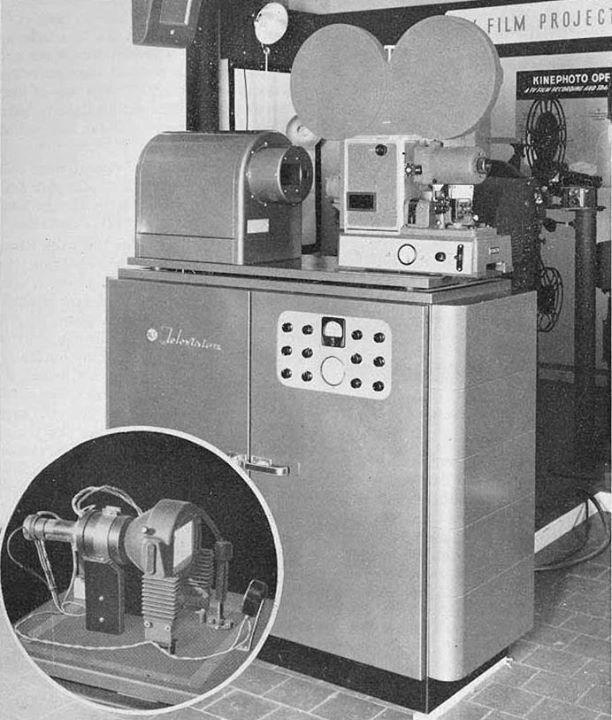



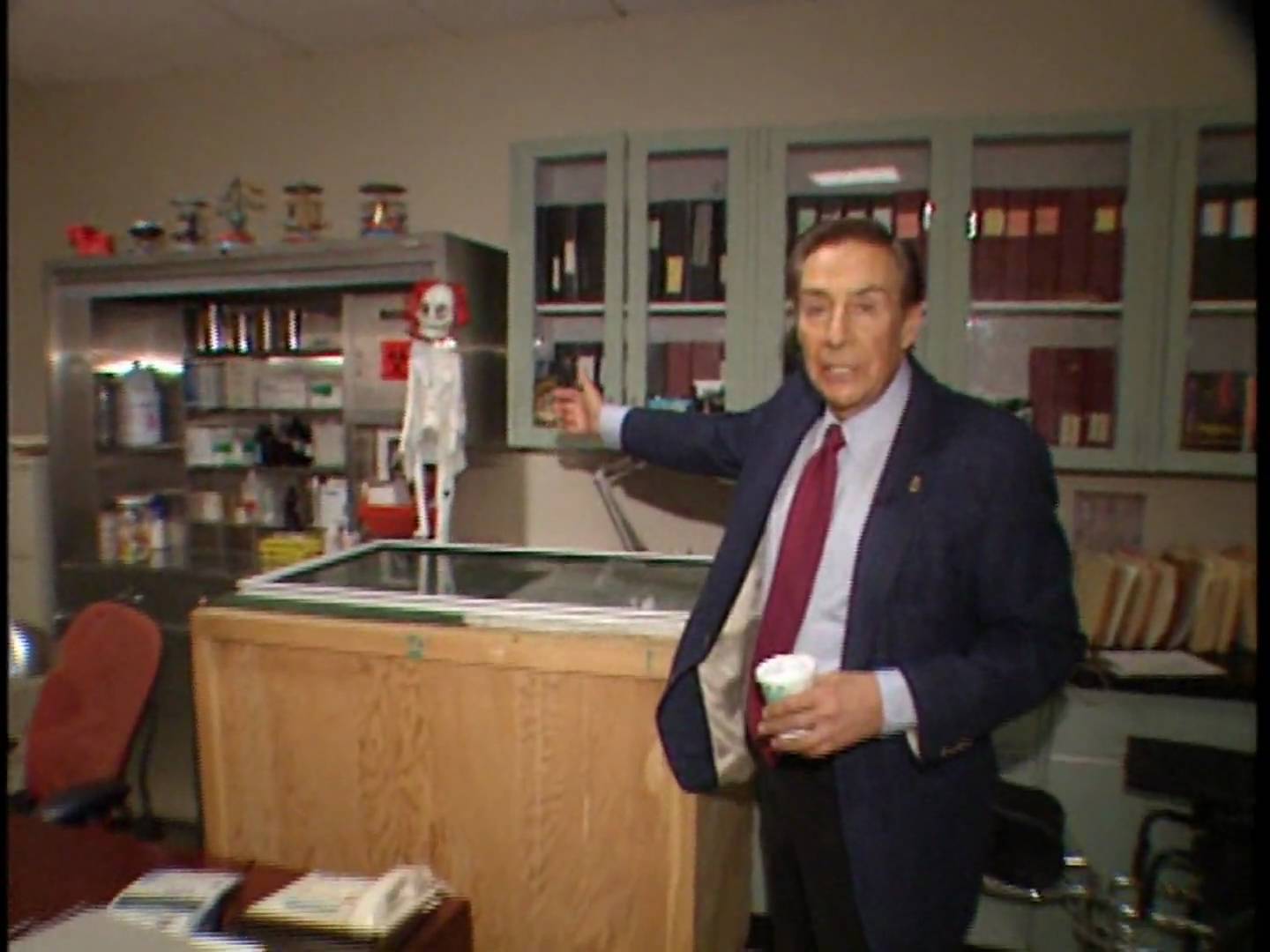

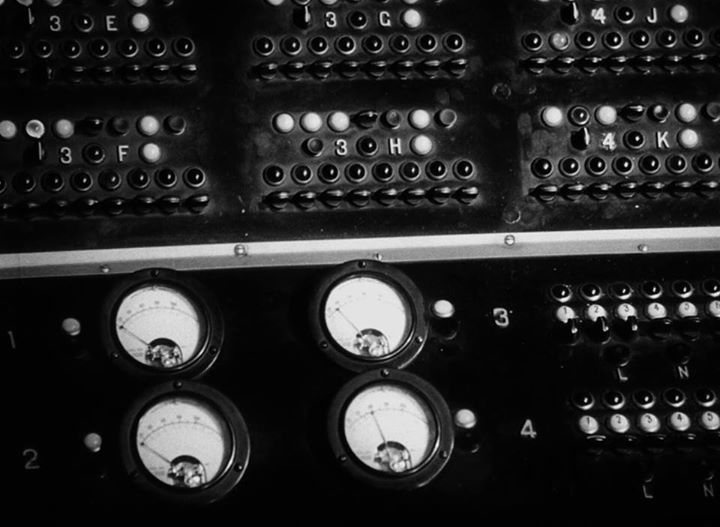

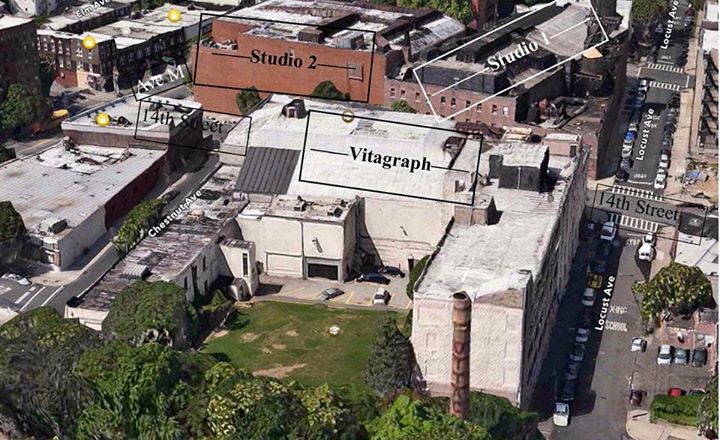

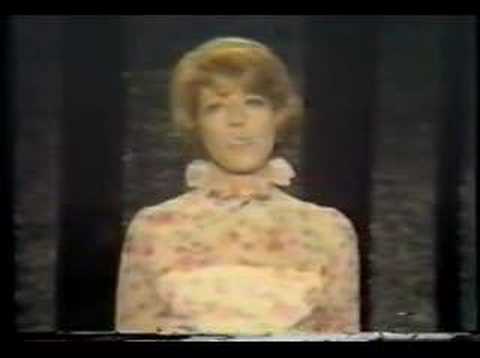

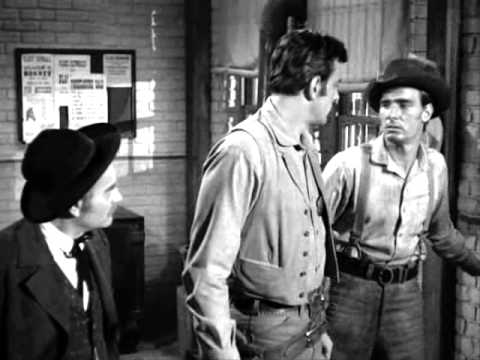



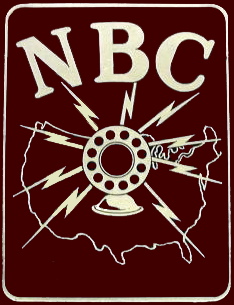

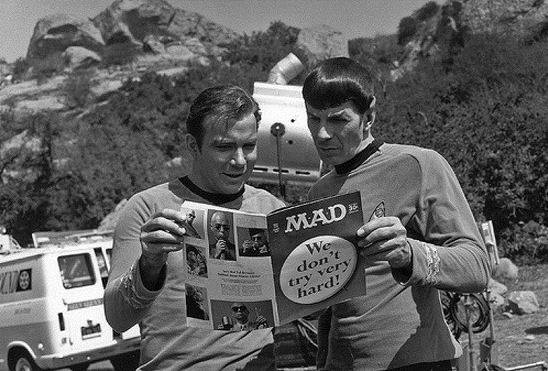

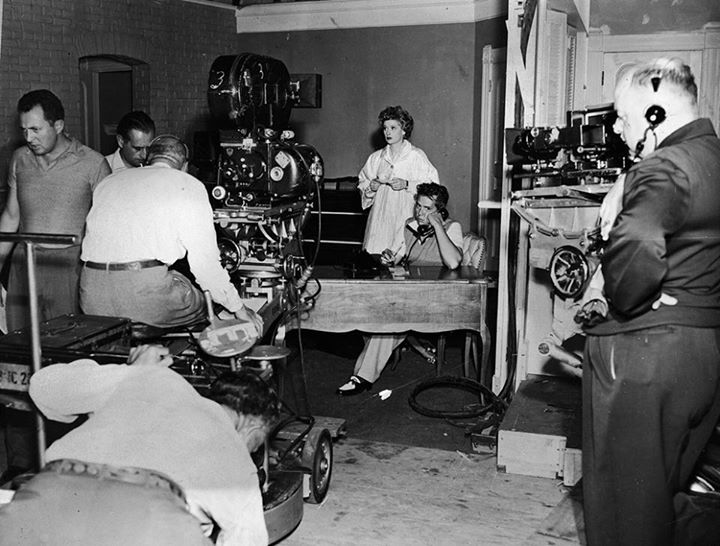





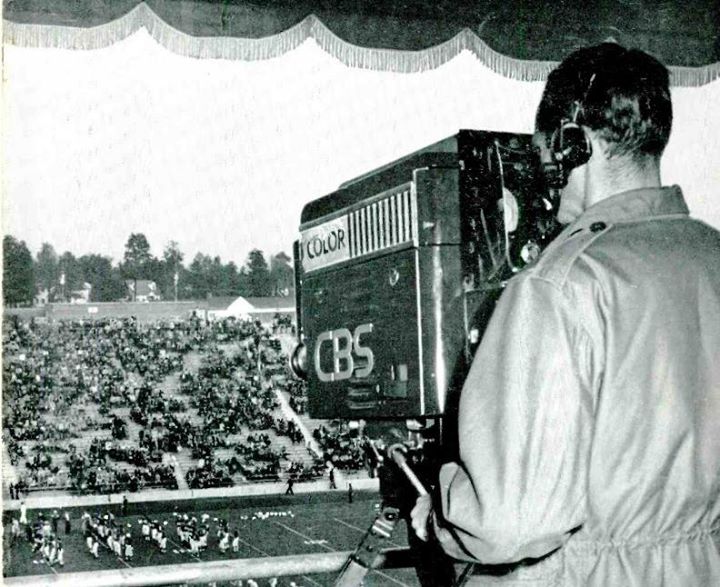



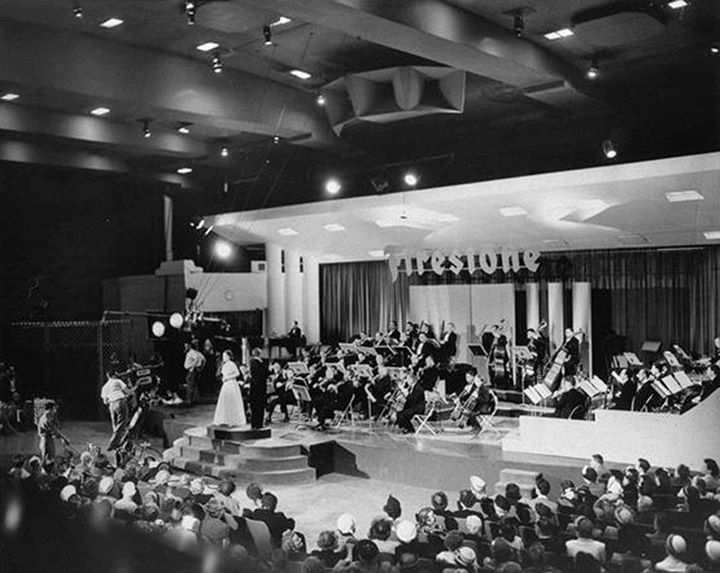

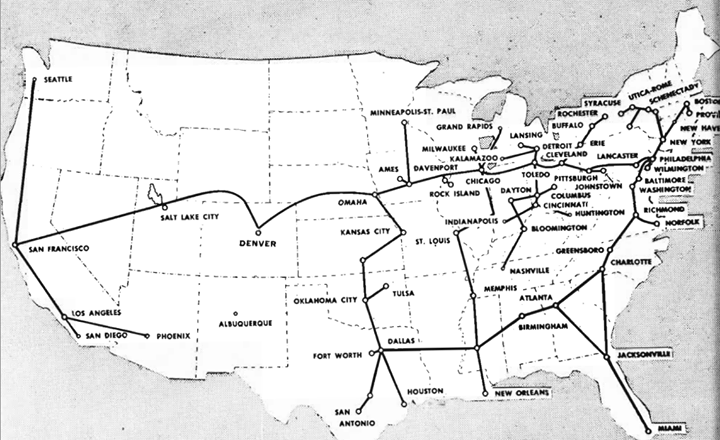

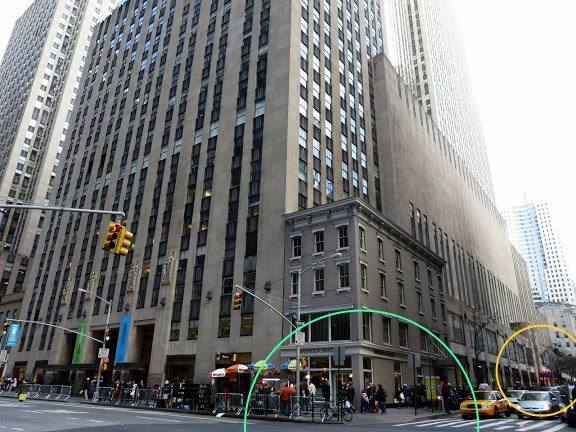



Posts in Category: TV History
Page 16 of 136
« Previous
1
2
3
4
5
6
7
8
9
10
11
12
13
14
15
16
17
18
19
20
21
22
23
24
25
26
27
28
29
30
31
32
33
34
35
36
37
38
39
40
41
42
43
44
45
46
47
48
49
50
51
52
53
54
55
56
57
58
59
60
61
62
63
64
65
66
67
68
69
70
71
72
73
74
75
76
77
78
79
80
81
82
83
84
85
86
87
88
89
90
91
92
93
94
95
96
97
98
99
100
101
102
103
104
105
106
107
108
109
110
111
112
113
114
115
116
117
118
119
120
121
122
123
124
125
126
127
128
129
130
131
132
133
134
135
136
Next » September 13, 1947…The RCA Kinescope Machine Debuts
On September 13, 2016
- TV History
September 13, 1947…The RCA Kinescope Machine Debuts
In association with Dumont, Kodak and RCA announced the developed a special film camera to shoot directly off a TV screen. This was the first “time shifting” technology to come to television. Nine years later, video tape would become the second.
Officially titled, the “Eastman Kodak Television Recording Camera”, a Kinescope recorder was basically a special 16mm film camera mounted in a large box aimed at a high quality monochrome video monitor. All things considered the Kinescope made high quality, and respectable TV recordings.
The Kinescope was quite the clever device. It’s film camera ran at a speed of 24 fps. Because the TV image repeated at 60 fields interlaced (30 fps) the film had to move intermittently between video frames and then be rock steady during exposure.
The pull-down period for the film frame was during the vertical interval of less than 2 mili seconds, which was something no mechanical contraption could do at the time.
Together, Dumont, RCA and Eastman Kodak found various ways around the problem by creating a novel shutter system that used an extra six frames of the 30 frame video signal to move the film. This action integrated the video half-images into what seemed like smooth 24 fps film pictures.
Of course, the kines were played back on air using film chains running at 24 fps, so the conversion to film was complete and seamless. Until videotape recorders made their debut, the Kinescope was the only way to transmit delayed television programs that were produced live.


September 13, 1953…Marilyn Monroe’s First Network TV Appearance
On September 13, 2016
- TV History
September 13, 1953…Marilyn Monroe’s First Television Appearance
In the Comment section below, you’ll see the gift Jack Benny gave Marilyn for appearing on his show. She was reluctant and didn’t really want to do it because on live television, to many things could go wrong, but the “gift” helped, as did the studio executives who saw this as a great promo for her new movie “Gentlemen Prefer Blonds” which went into general release in August of ’53.
This was the first show of Benny’s fourth season and having lost thirty percent of his audience in the third season, he was anxious to step up the guest star power. It worked and the ratings zoomed. -Bobby Ellerbee
https://www.youtube.com/watch?v=_vhQqJXJz-o
On September 13, 1953 The Jack Benny Show episode with Marilyn Monroe aired on CBS. I really enjoy this episode! Marilyn is such a sweetheart and did a great…


September 13, 1990…”Law And Order” Debuts On NBC
On September 13, 2016
- TV History
September 13, 1990…”Law And Order” Debuts On NBC
Below is a tour or the set from the beloved Jerry Orbach.
“Law And Order” and “Gunsmoke” are tied for the honor of television’s longest running live action primetime series…both lasted 20 years, but “Gunsmoke” aired more episodes, so it still holds the record. FYI, “The Simpsons” is actually the winner with 28 seasons, and “South Park” also has 20 season, but those are animated. Doh!
“Law And Order” is the only show that was sold to three networks before it got to air. Initially, Fox ordered thirteen episodes based on the concept alone, with no pilot. Then-network head Barry Diller reversed the decision. Although he loved the idea, he didn’t believe it was a “Fox show”.
Dick Wolf then went to CBS, which ordered a pilot, “Everybody’s Favorite Bagman”, written by Wolf about corrupt city officials involved with the mob. The network liked the pilot but did not order it because there were no breakout stars.
In the summer of 1989, NBC’s top executives, Brandon Tartikoff and Warren Littlefield, screened the pilot and liked it; but they were concerned the intensity of the series could not be repeated week after week. However, by 1990, NBC executives had enough confidence that the innovative show could appeal to a wide audience that they ordered the series for a full season.
The rest as they say, is history…and a great one at that! This is my all time favorite show. Yours too? Enjoy and share! – Bobby Ellerbee
September 12, 1955…3K, NBC’s First Color Studio Inside 30 Rock Debuts
On September 12, 2016
- TV History
September 12, 1955…3K, NBC’s First Color Studio Inside 30 Rock Debuts
On this day (also a Monday), in 1955, Studio 3K debuted as NBC’s first “non-experimental“* in-house color facility. It was created by combining historic Studio 3H, television’s first home, and radio Studio 3F. The debut broadcast was of “The Howdy Doody Show”, and 3K became Howdy’s premenant home, making it the first ever daily color broadcast. *In 1951, RCA/NBC equipped Studio 3K with experimental color equipment for a year’s worth of testing monitors, cameras and rack equipment and mostly closed circuit programs were done from 3H until The Colonial Theater was leased and became the home of all the color broadcasts, starting in March of 1953…so, technically, Studio 3H was the first live color studio inside 30 Rock.
Below is the detailed history of Studio 3H, how it came to be, and what it became. Did you know 3K was the home of the famous Kraft Kitchen? That is were all the Kraft commercials came from, and why the third floor always smelled great. Enjoy and share! -Bobby Ellerbee
Inside Studio 3H, 3rd floor level studio above and below, 4th floor level control room that you can see in the photo above.
The “coffin camera” color tests that started in 3H in 1951 (below) with “Color Girl” Marie McNamara.
Me kissing the floor where 3H and 3F came together to make 3K, 2014.
A Brief History Of Television’s First Real Home…NBC’s Studio 3H
Above is a rare, digitally enhanced photo of the NBC Radio Master Control board from 1933…the year RCA and NBC moved into 30 Rockefeller Plaza.
In the beginning, Studio 33 was radio studio, just one of six medium sized spaces on the 3rd floor, which were about half the size of 3A and 3B. At the time, there were roughly 50 NBC studios in the building, but RCA had plans for 3H.
In late 1935, two years after Radio City opened, NBC Radio Studio 3H was converted to RCA Television Studio 3H and technically, would remain an RCA domain until 1939, at which time W2XBS and this studio were put under the control of NBC Television.
It was done under a blanket of secrecy. This mysterious new space was kept secret due to competitive developments for a year, while low key experimental broadcasts from 3H were done, but by early in 1936, RCA decided to go public with the news of their electronic television operations.
After the experimental public broadcasts were started with the three live Iconoscope cameras, RCA also took over a space on the 5th floor for film and called that new area Studio 5F, which was linked to the 3H control room.
Until 1951, 3H was used for experimental and regular programming, and was NBC’s only permanently equipped studio till radio studio 8G began television trials in 1946. Some of the earliest network shows from 3H were “The Kraft Music Hall,” “Television Scene Magazine,” “The Howdy Doody Show” and more. All these shows started out in 3H with the big Iconoscope cameras, and in April of 1948, 3H finally got the new RCA TK30s. The next month, 8G was converted to television.
In 1951, Howdy and the other shows done here moved out, and 3H would become the home of the experimental color tests after the Wardman Park color tests concluded in Washington. The Wardman color cameras were not installed in 3H, however the Washington color veterans were brought from there to continue color tests with the new “coffin cameras.” The joke was, these huge new umber gray cameras were big enough to bury a man in. These were the predecessor to the TK40s and this is the first appearance of the rounded top viewfinder. The color tests from 3H, and later, The Colonial Theater were broadcast over RCA’s experimental color station KE2XJV.
Variety like demonstration shows were done weekdays at 10, 2 and 4 and were staged with vivid colored wardrobes and sets. These shows were mostly for the engineers in New York and RCA’s Princeton labs who watched on closed circuit feeds. Not one to ever miss a marketing opportunity though, these shows were also fed to a half dozen custom built color receivers that were on display in the RCA Exhibition Hall in Rockefeller Plaza. In early ’53 these daily shows would move to The Colonial Theater which was where the new prototype TK40 cameras were beginning to be tested.
After the color tests left for the Colonial, 3H was still involved in color monitor tests, but even then, it stayed busy with regular 15 minute daily programs and live commercials coming from the studio with TK30s wheeled in from Studio 3B.
In the summer of 1955 3H was closed as construction crews took out the wall between 3H and 3F to create the first color studio inside Radio City. The new studio was to become 3K and with a double debut, both Studio 3K and Howdy Doody went to live color the afternoon of September 12, 1955.
Today, 3K is used by MSNBC and is the home to most of their hosts after 7PM, including Chris Hayes, and Lawrence O’Donnell. There is more on the photos, so click through! Enjoy, and there is more to come on 3H. -Bobby Ellerbee
September 12, 1954…Brooklyn 1, NBC’s Second Color Studio Debuts
On September 12, 2016
- TV History
September 12, 1954…Brooklyn 1, NBC’s Second Color Studio Debuts
The full story is below, but at this link is a tour of Brooklyn 1 by Steve Allan, just after NBC’s first color spectacular “Satin & Spurs”, aired live from this new color studio September 12, 1954. Enjoy and share! -Bobby Ellerbee
A Rare And Detailed Look At NBC’s Brooklyn Studios…Part 1 of 2
For me, these new photos and information have cleared up a lot of confusion about these famous and historic film and television studios. I hope they will do the same for you.
Here are two annotated aerial views of the property and the recently discovered September 29, 1951 article from the Brooklyn Eagle that announces the sale of the Warner Brothers – Vitagraph property to NBC.
I had always thought that NBC bought the entire Warner Brothers holdings in Brooklyn…the studios and property that WB had bought from Vitagraph Studios. This is not the case. As it turns out, the big white building was retained by WB, but they sold the property on the other side of 14th Street to NBC. This will not surprise you but Wikipedia and other wiki sites have a lot of wrong information on this.
The white Vitagraph building was built in 1906. Vitagraph was bought by Warner Brothers April 22, 1925. What we now know as NBC Brooklyn Studio 1 was built by WB in 1936 and was first used by NBC September 12, 1954. Studio II, the smaller studio was built new from the ground up by NBC and went into service in the fall of 1956.
All of this sheds new light on a bigger picture…a big color picture! As I compare notes on dates and locations, it is dawning on me that with the broadcast of ‘Satin And Spurs’ on September 12, 1954, NBC Brooklyn Studio I, became NBC’s second ever color facility. That is a fact I have never seen documented anywhere before, even in NBC’s press releases of the time.
It’s interesting to note that this property was bought about the same time RCA/NBC took over The Colonial Theater. That was NBC’s first real color facility and after transforming it from a movie theater to a color television studio, the first live broadcast was done from The Colonial on November 8, 1952 with a one time only broadcast of ‘Your Show Of Shows’ with the color burst removed, but viewed in color via closed at RCA Labs in Princeton.
I suspect the three year gap between when NBC bought the property and it’s first use was due in large part to a wait and see attitude regarding the NTSC color system court battles with CBS and the FCC. When CBS testified before Congress in March 1953 that it had no further plans for its own color system, the path was open for the NTSC to submit its petition for FCC approval in July 1953, which was granted in December. I think that is when NBC finally began the serious work of transforming Studio I from a film sound stage into the world’s largest color television studio.
Now that we’ve seen the outside and made some new discoveries, we’ll move to the inside of these two studios tomorrow with some great pictures. Thanks to Glenn Mack for the aerial views, Dave Miller for the Brooklyn Eagle article and to many NBC veterans that helped with this including Joel Spector, Dennis Degan, Jan Kassoff, Frank Gaeta, Russell Ross and more. Enjoy and SHARE! -Bobby Ellerbee


September 11, 1967…”The Carol Burnett Show” Debuts on CBS
On September 11, 2016
- TV History
September 11, 1967…”The Carol Burnett Show” Debuts on CBS
After leaving the “Garry Moore Show” in 1962, Burnett signed a 10 year contract with CBS with 2 options. Option 1 required her to do two guest appearances and a special each year, which she did for the first five years.
Option 2 gave her 30 weeks in her own show. After discussion with her husband Joe Hamilton, in the fifth year of the contract, Burnett decided to call CBS and exercise Option 2 of the contract. Mike Dann of CBS Programming, explaining that the variety show Carroll wanted to do was a “man’s genre”, offered Burnett a sitcom called “Here’s Agnes”. Burnett had no interest in doing a sitcom and because of the contract, CBS was obliged to give Burnett her own variety show. The rest as they say is history!
The original show ran on CBS from September 11, 1967, to March 29, 1978, for 278 episodes and originated in CBS Television City’s Studio 33. It won 25 prime-time Emmy Awards, was ranked No. 16 on TV Guide’s 50 Greatest TV Shows of All Time in 2002, and in 2007 was listed as one of Time magazine’s “100 Best TV Shows of All Time.” Enjoy and share! -Bobby Ellerbee
#t=106″ target=”_blank”>https://www.youtube.com/watch?v=JlF4GVVi6Ss #t=106
Bloopers from the classic CBS variety show.


September 10, 1955…”Gunsmoke” Debuts With John Wayne Intro
On September 10, 2016
- TV History
September 10, 1955…”Gunsmoke” Debuts With John Wayne Intro
According to “The Complete Directory to Prime Time Network and Cable TV Shows”, John Wayne was the first choice to play Marshal Matt Dillon, but he declined because he did not want to commit to a weekly TV series. He did, however, recommend his friend James Arness for the role, and gave the on-camera introduction in the pilot, which is included here.
According to a TV Guide article, 26 actors screen-tested for the role of Matt Dillon. William Conrad (voice of radio’s Matt Dillon) was one, but didn’t look the part. Raymond Burr sounded great, but according to producer-director Charles Marquis Warren: “he was too big; when he stood up his chair stood up with him” (Burr later lost considerable weight to play Perry Mason).
John Pickard almost made it, but did poorly in a love scene with Kitty. Warren and producer Norman MacDonnell denied that they even considered John Wayne, but their choice for Marshall Dillon, James Arness, looked and sounded a lot like Wayne. When Arness was reluctant to take the role, Wayne persuaded him and even agreed to introduce the first episode.
‘Gunsmoke’ was created by writer John Meston and producer Norman MacDonnell as a radio series that premiered on CBS in 1952. Many of the early television episodes are adaptations of Meston’s radio scripts. The radio series ran for more than 400 episodes and lasted until 1961.
The gunfight between Matt Dillon and an unknown gunman that opened every episode was shot on the same main street as that used in High Noon (1952). During one filming of this gunfight, as a joke on everyone else, James Arness let the gunman win.
During WWII, James Arness was assigned to the 3rd Infantry Division and took part in the invasion of Anzio where he was severely wounded in the leg and foot by machine-gun fire. He lost part of his foot and the wound plagued him the rest of his life. The injury made it difficult for him to walk for extended stretches, so, when shooting movies or TV shows, any scenes that required extensive walking would be shot early in the morning, before his feet and knees started giving out.
At 20 years and 635 episodes, ‘Gunsmoke’ is one of the longest-running American prime-time drama television series. It was originally produced for the CBS Television Network by Filmcrafters at the Producers Studio (now the Raleigh Studio). Around 1960, CBS took over production and moved it to KTLA Studios, then owned by Paramount Pictures. Around 1963 production was moved to CBS Studio Center, formerly Republic Studios, where it remained for the rest of the show’s run.
Slated to be canceled in 1967 due to low ratings, CBS president William Paley reversed the decision. He moved the show from Saturdays to Mondays (cancelling Gilligan’s Island in the process), placing it back in the Nielsen’s Top Ten. Paley and his wife were both big fans of the show. -Bobby Ellerbee


September 9, 1963…”Huntley – Brinkley Report” Goes To Half Hour Format
On September 9, 2016
- TV History
September 9, 1963…”Huntley – Brinkley Report” Goes To Half Hour Format
A week after CBS took Walter Cronkite’s evening news show to 30 minutes, NBC followed. On that first extended broadcast, a taped interview with President Kennedy was included. These are rare photos taken that morning in the Oval Office. Much more below. Enjoy and share! -Bobby Ellerbee
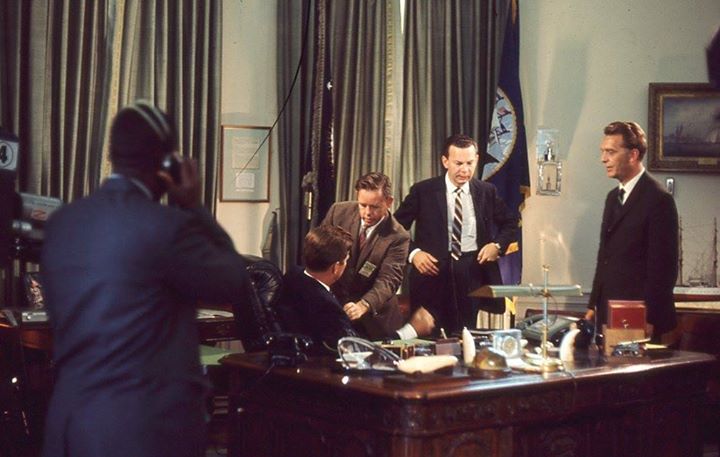
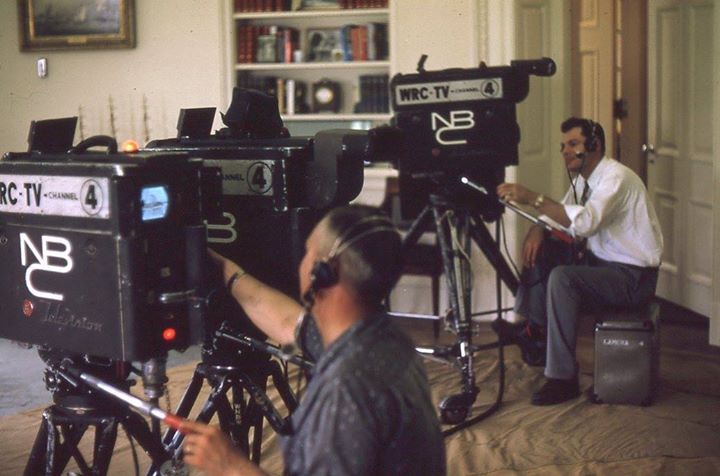
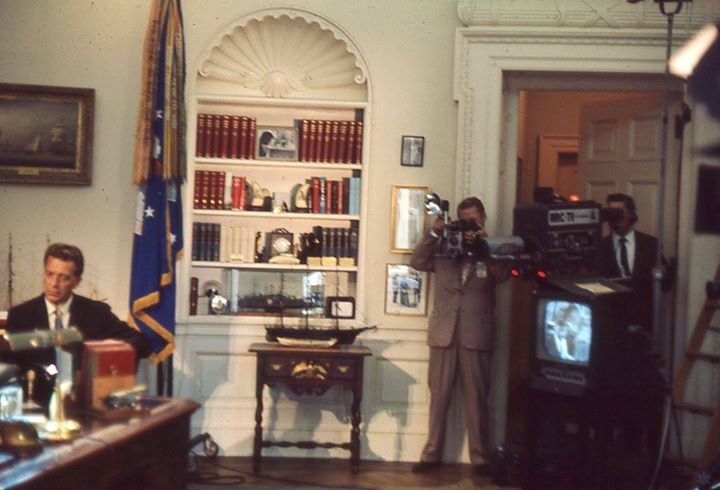

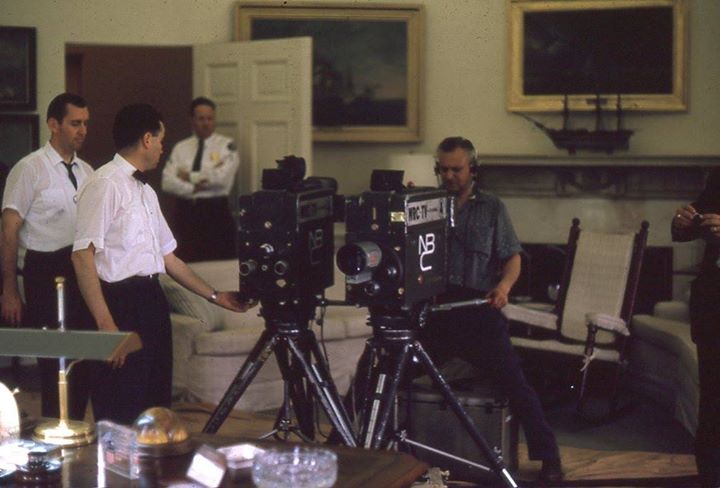



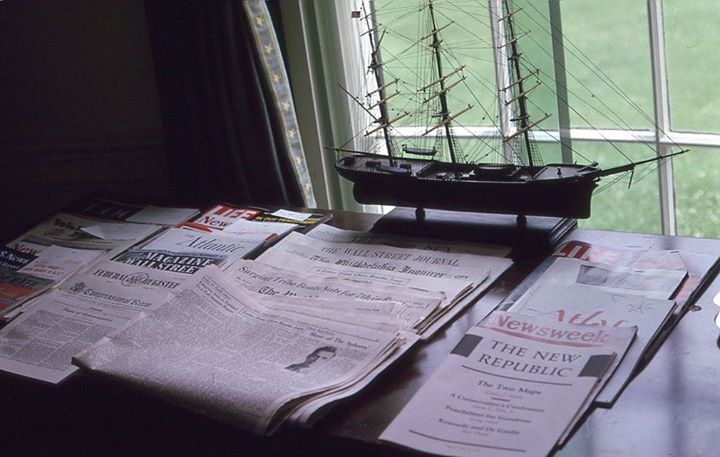
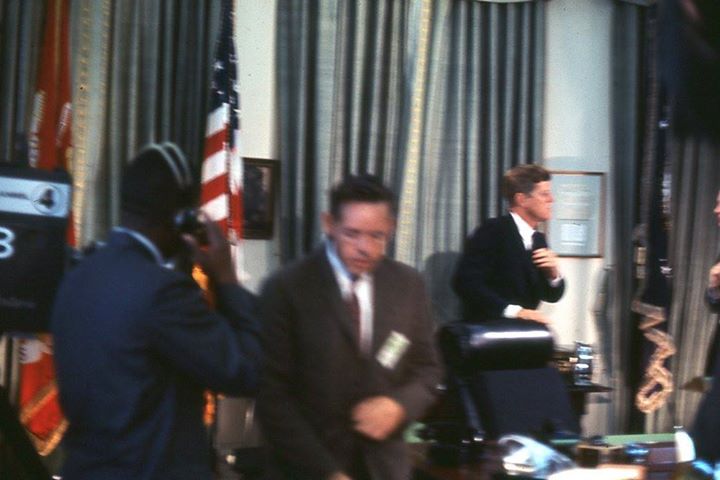
ULTRA RARE! JFK, Huntley-Brinkley Interview In The Oval Office
At the link above are videotape outtakes, from what would be President Kennedy’s last interview on NBC.
The date is September 9, 1963, and these rare behind the scenes photos were taken by long time NBC/WRC-TV production manager, Bill Wells, and are made available to us by his friend, Tom Buckley, and the Wells estate.
As seen in these remarkable photos, NBC reporters Chet Huntley and David Brinkley sat down with the President in the White House for an exclusive interview for their program, “The Huntley-Brinkley Report”.
Kennedy stuck to outlining the policy priorities of his first term throughout the expansive interview, particularly focusing on the conflict in Southeast Asia. But he grew reflective when Huntley asked if, three years into his presidency, he found the office of the presidency unmanageable.
Kennedy gave a strikingly thoughtful, long response assessing America’s place in the world and economic issues and political roadblocks at home – essentially summing up all the challenges facing his presidency. But Kennedy ended on a hopeful and humble note, saying that the country was really managed – not by the White House, but by its citizens.
He concluded that America was making progress and said, “I think we can really look forward to the ’60s with a great deal of hope.” Tragically, of course, Kennedy would not outlive the decade for which he had so much hope, nor the the year of 1963.
In that these images are so rare, I’m sure you have friends that you would like to share them with, so please do. If you can help identify the people shown here, that would be appreciated too. -Bobby Ellerbee
September 9, 1926…RCA Creates NBC: A History Lesson
On September 9, 2016
- TV History
September 9, 1926…RCA Creates NBC: A History Lesson
In the beginning, there was David Sarnoff. By 1919, Sarnoff was the commercial manager of American Marconi in New York. That same year, British Marconi had made an offer to General Electric to buy the worldwide rights to their Alexanderson Alternator technology which was vital for transatlantic communication.
The prospect of a foreign company controlling international communications set off alarm bells in Washington and the government approached GE with a counter offer. If GE would place the Alternator in a new subsidiary company, they would be allowed to operate the international wireless circuits for both government and commercial traffic.
To sweeten the deal, the Navy agreed to turn over all the wireless patents it received through their wartime research. Who could refuse? The new GE subsidiary company was named the Radio Corporation of America and at the helm was Owen Young as Chairman, Ernst Alexanderson as Chief Engineer and David Sarnoff as General Manager.
Within months, AT&T, Westinghouse and a big customer of international wireless services, United Fruit Company bought up all the RCA shares. By 1921, things had gotten interesting on another front…radio stations. 28 sprang up that year including the Westinghouse owned WJZ in New Jersey.
With the July 2, 1921 World Heavyweight Championship fight between America’s Jack Dempsey and France’s George Carpentier looming, the nation was anxious for a speedy way to know the details and outcome. David Sarnoff decided RCA should broadcast the fight on WJZ. It was a radio first; a publicity coup for RCA and Westinghouse, and sold lots of radios!
With Westinghouse in a good mood, Sarnoff convinced them to allow RCA to take over WJZ, and later that month, RCA built and installed a powerful new transmitter for their first station atop Aeolian Hall in New York. By the end of 1922, 430 more radio station licenses had been granted and Sarnoff was paying attention, but had a different train of thought.
To him, it seemed the bigger opportunity was not in owning local stations, but in creating a national network. In a memo to Chairman Owen Young, Sarnoff said that RCA should provide “a national broadcasting company” that would entertain a nation with high quality programs of news, sports and music. The plans for The National Broadcasting Company were in place now, but it would take a few more years.
Part of RCA’s original corporate mandate was to issue and collect licensing fees from those manufacturing wireless radio equipment. That meant everyone; including one of RCA’s major shareholders… AT&T. Even though they would be rewarded by their stock ownership, AT&T began to chafe at the bit and in early 1923, began manufacturing receivers without paying the license fees to RCA. On top of that, they had also refused to allow RCA to lease phone lines to begin a network for WJZ. RCA’s only alternative was to use telegraph lines which had very poor voice quality. In the summer of ’24, there were some anti-Semitic remarks aimed at Sarnoff by AT&T head Walter Gilbert, and things got pretty heated, but that actually worked to RCA’s advantage.
After that embarrassing flap, AT&T’s management began to discuss getting out of the radio business, and in July of 1926, AT&T agreed to sell WEAF to RCA. The sale came with the stipulation that from then on, they would rent AT&T lines, which is what Sarnoff wanted all along.
The Beginning of NBC, September 9, 1926…NBC Was Incorporated By RCA The incorporation process was the first step on a long and profitable road for RCA’s new broadcast division.
The nation’s first major broadcasting network came to life on November 15, 1926, with a gala four-hour radio program originating from the ballroom of the original Waldorf-Astoria Hotel at 5th Avenue and 34th Street, which is now the Empire State Building’s location.
After NBC was created, their two stations became the centers of their two semi-independent networks…NBC Blue, based on WJZ, and NBC Red, based on WEAF, each with its respective links to stations in other cities. RCA became the network’s sole owner January 1, 1930, when former partners General Electric and Westinghouse were bought out.
Many believe that NBC created the first radio network but that is not exactly the case. RCA’s old partner AT&T had the first radio network and their first network radio broadcast was January 4, 1923 between WEAF in NYC and WNAC in Boston. -Bobby Ellerbee
September 8, 1966…”Star Trek” Debuts On NBC
On September 8, 2016
- TV History
September 8, 1966…”Star Trek” Debuts On NBC
“The Man Trap” was the first episode of a television series that has become a trek unto itself…it aired 50 years ago today.
The first season of ‘Star Trek’ comprised 29 episodes, including the two-part episode “The Menagerie”, which was based on the original pilot, “The Cage” which had starred Jeffrey Hunter as Captain Christopher Pike.
As you probably know, there were two pilots done for this show and the second was “Where No Man Has Gone Before” with William Shatner as Captain Kirk. That pilot was re edited with some new footage and aired as the third episode of that first season. Enjoy and share! – Bobby Ellerbee
September 8, 1951…First Episode Of “I Love Lucy” Was Filmed
On September 8, 2016
- TV History
September 8, 1951…First Episode Of “I Love Lucy” Was Filmed
When ‘I Love Lucy’ debuted October 15, 1951, the first episode to air was “The Girls Want To Go To A Nightclub”, but the first episode to be filmed was “Lucy Thinks Ricky Is Trying To Murder Her” which was filmed on September 8, 1951. It aired as the fourth episode on November 5th.
This rare schedule shows the rehearsals and shooting times at The General Services Studios location, which is where the show was done for the first three seasons. Enjoy and share! -Bobby Ellerbee


September 7, 1927…First Electronic Television Demonstrated
On September 7, 2016
- TV History
September 7, 1927…First Electronic Television Demonstrated
While others were trying to perfect mechanical television, Philo T. Farnsworth was creating the Image Dissector tube which was the heart of his electronic television system. RCA’s Vladimir Zworykin developed the Iconoscope tube and later the Orthicon tube, but it was only when he incorporated ideas from Philo’s Image Dissector tube that the great Image Orthicon tube was born. Enjoy and share this excellent 10 minute tribute to Mr. Farnsworth which includes rare color film of his 1939 experiments too. -Bobby Ellerbee
https://www.youtube.com/watch?v=HHy04aN0jfI
Philo Farnsworth invented television from an idea he had at 14 years old. Yet no one knows his name. His great grand daughter Jessica tries to set the record…
September 7, 1957…NBC Debuts The Animated Living Color Peacock
On September 7, 2016
- TV History
September 7, 1957…NBC Debuts The Animated Living Color Peacock
https://www.youtube.com/watch?v=Ug9ndBnWi9A
At the link is the original version. This animated film clip rolled at NBC for the first time at the start of “Your Hit Parade” which originated from The Ziegfeld Theater, and the voice belongs to legendary NBC announcer Ben Grauer. The animation was done by Electra Film Labs in New York City. The man who designed the peacock is John J. Graham. Below is a rare set of photos and the story of John Graham’s development of most of NBC’s dramatic logos, including “The Snake”. Enjoy and share!
http://big13.com/NBC%20Peacock/NBCPeacock1.htm
First, a huge thanks to our friend Mike Clark and his great “Big 13” website for this amazing, rare and unique story on the peacock and it’s creator, John Graham. At the link, you will see one of a kind images of the original artwork that Mike got from Graham’s son, Bruce.
With the help of our mutual friend David Schwartz, one of television’s top historians, Mike lays out the complete behind the scenes story like you will never see anywhere else. This is a “must see” effort and even includes the development of the NBC Snake logo, the first 1954 color chimes logo, the ‘Laramie Peacock’ animation and much more.
I’ve pulled out a few of the historic peacock photos because today is the 57th anniversary of that animations use at the top of ‘Your Hit Parade’, but you’ll want to see rest! Thanks to Mike Clark for this great effort and for letting us see it. More on the photos. Enjoy and please share this! – Bobby Ellerbee
An Inside Look At The Final CBS Color Test…October 20, 1951
On September 6, 2016
- TV History
An Inside Look At The Final CBS Color Test…October 20, 1951
Thanks to Tom Buckley for this wonderful IBEW Newsletter article from January of ’52, that gives us intimate details of that last test broadcast of the CBS Field Sequential Color System.
The article not only names everybody on the 12 man crew, but in just three pages, gives us a great overview of the system’s history, and the details of how CBS came to fold the tent on this work. A “must read” for anyone interested in television’s color wars. Enjoy and Share! -Bobby Ellerbee


Rare Jerry Lewis Labor Day Marathon Video
On September 5, 2016
- TV History
Rare Jerry Lewis Labor Day Marathon Video…
I’ve started this 2 hour video with Jerry and Frank Sinatra rehearsing, via satellite, for a pretaped insert a day before the show.
This is raw footage from a 1989 special planned by “A Current Affair”…remember that? Jerry is in top form and there are stars everywhere, plus interesting backstage footage that shows Lewis in ways we never see him. Happy Labor Day! Enjoy and share. -Bobby Ellerbee
https://www.youtube.com/watch?v=tYrjtEvmLA0
Cinéma des Singes Hurlant Dame Entreprises présenter a nonfiction found-footage-not-for-profit-film starring Jerry Lewis.
September 5, 1949…NBC Studio 8H Make Its Television Debut
On September 5, 2016
- TV History
September 5, 1949…NBC Studio 8H Make Its Television Debut
On this day in 1949, NBC’s famous Studio 8H made it’s television debut, as did “The Voice Of Firestone” radio program in a special simulcast. Every Monday night since 1928, the show had been heard on radio, but in the ’49 season, it also came to television.
The show was covered as a “remote” as 8H was still a radio studio, and had no television capacity. Three RCA TK30s were rolled in, along with portable CCUs and a switcher, and connected by cable to master control on the 5th floor.
In the video linked here, you can see one of the shows from that season with a special twist. At the :17 second mark, you can see an one of the RCA TK30s remote cameras push into the background. The cameraman is our friend Frank Merklein, as the stage camera was his usual position on Firestone. He liked shooting the oboe player and did so weekly. That oboe player later had his own hit show on NBC…it was Mitch Miller. For music lovers, at 2:15, one of the most passionate passages in opera erupts in this presentation of “Pagliacci”. Enjoy! -Bobby Ellerbee
By the way, there had been earlier TV remotes from 8H, but those we occasional broadcasts of “Toscannini & The NBC Symphony” concerts and were not regularly scheduled. Firestone was the first regularly scheduled broadcast from here. There was an earlier televised show called “The Voice Of Firestone Televues”, but that was only a Firestone sponsored show, and was a series of travelogues and short films in 1943. The real ‘Voice Of Firestone” was a one hour weekly music show that often featured operatic fare.


September 4, 1951…America’s First Coast To Coast TV Broadcast
On September 4, 2016
- TV History
September 4, 1951…America’s First Coast To Coast TV Broadcast
65 years ago today, the first live transcontinental television signals were transmitted from San Francisco to New York, as President Harry S. Truman’s opening speech before the Japanese Peace Conference was broadcast across the nation.
This was the debut of AT&T’s new route of long lines and state-of-the-art microwave technology, with the microwave transmission covering about a quarter of the route west of Denver. The historic broadcast was picked up by 87 stations in 47 cities on all 4 TV networks. (ABC, CBS, Dumont, NBC).
Part of the speech can be seen here.
This is was the configuration of the new coast-to-coast AT&T broadcast net for television. There was a total of 109 operating TV stations serving 64 markets. There were 40 one station markets, 10 two station markets 10 three station markets, and 4 four station markets. At the time, only 63 cities were connected to the AT&T net to receive live television broadcasts. Enjoy and share! -Bobby Ellerbee
A 1958 Dress Rehearsal, At “The Ed Sullivan Show”
On September 3, 2016
- TV History
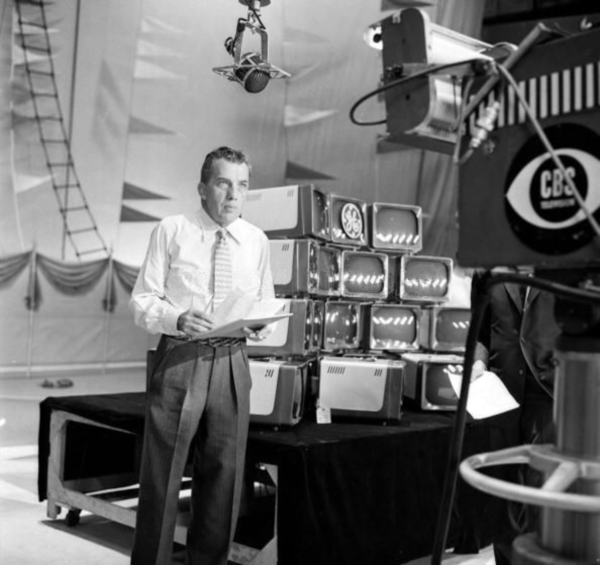
Before all the live shots below were made on a Sunday night in December of 1958, there was a rehearsal. Here, from earlier in the day, is Ed checking the script of his live GE spot against the script on a paper roll teleprompter mounted on a TK30.
Photo courtesy Life Magazine.
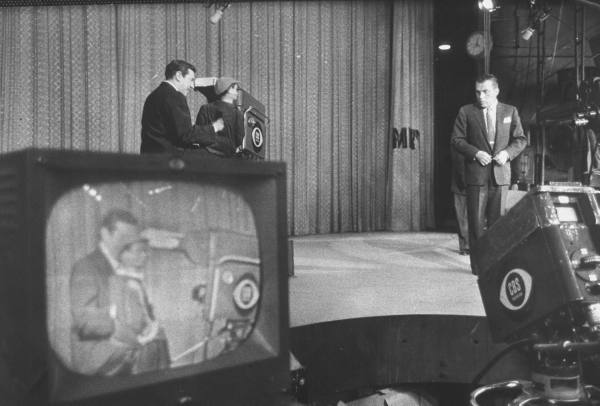
Above is ventriloquist Rickey Layne live on The Ed Sullivan Show. Interestingly, one of CBS’s new TK 11/31s is being used as a prop. Too bad it has a homemade cardboard “helper” on the viewfinder hood. In my humble opinion, the best viewfinder hood style ever developed came on the TK60s, 42s and 44s; it was nice and deep, but the bottom was open and made it easy to see the viewfinder…but, I digress. Notice a TK30 in the foreground for stage level shots.
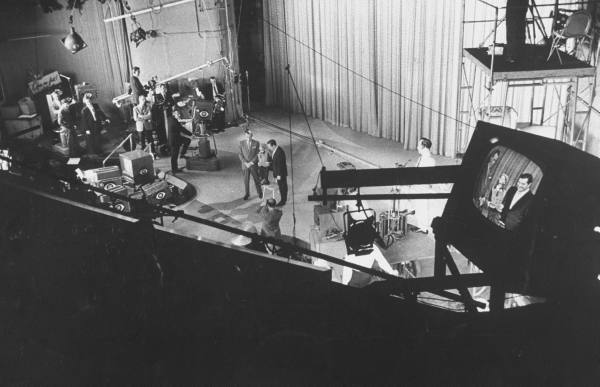
Look closely and you can count six cameras in this picture. The picture just below helps confirm models. There are two TK30s and four TK11/31s on the stage Studio 50. Two TK11/31s are in the upper right, and in the group of three shooting Ed, there’s an 11/31 on the crane, an 11/31 on the camera ramp and a TK30 on the audience floor just below the monitor. There is a TK30 stage right as well, as can be seen below. This facility has had an incredible history and if you want to know all about it, just keep reading this page…it’s all below.

This great shot from the back of the theatre shows a couple of the new TK11/31s together. One is on a Houston Fearless crane and one is on a pedestal, with one of the TK30s in the wings and one on the floor for a stage level shot (just under the crane cameraman’s seat). There are two more TK11/31s on stage left, ready for live spots, as you can see area for commercials on the far left. One of those cameras on stage left is probably only used for shooting title cards.
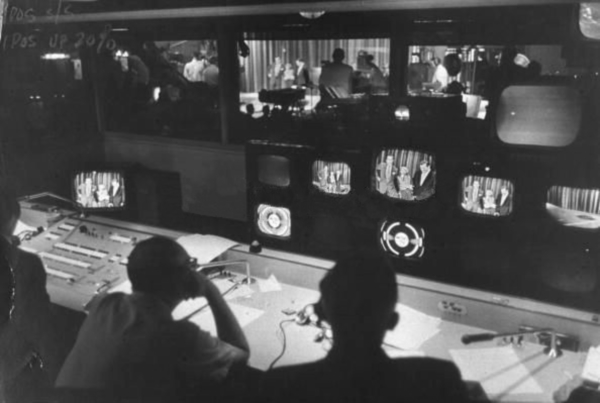
Here is a great shot from the control room.
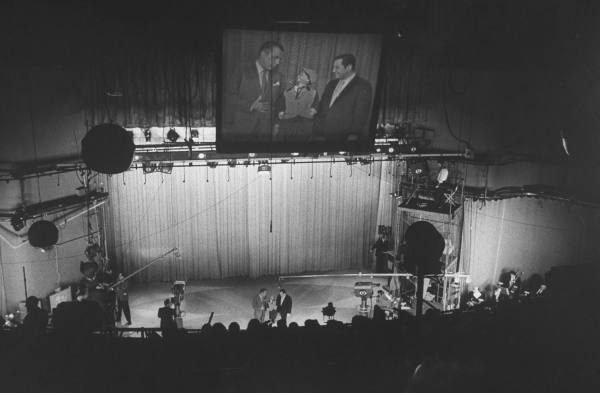
The pictures above and this one from the balcony give us a really great view of how the stage was laid out, and this shows how the balcony audience got to see the show. The round black object in the right foreground is the head of an RCA front screen video projection unit. In the right hand corner, just above the balcony’s rim, you can see a few members of the Ray Bloch Orchestra. On that same side, under the balcony and at the end of the orchestra section, is the audio booth where Art Shine made every singer and band shine for the entire 23-year run of The Ed Sullivan Show. Art also worked the Jackie Gleason program and the Dorsey Brothers’ Stage Show that originated here on Saturday nights.
Below is a history of the show and below that, a history of this still vibrant television landmark. Both are from the official Ed Sullivan web site. It is excellent and brimming with details of every aspect of the show. You can go there by clicking here.
HISTORY OF THE ED SULLIVAN SHOW
The Ed Sullivan Show aired from 1948 until 1971 and changed the landscape of American television. Sullivan’s stage was home to iconic performances by groundbreaking artists from rock ‘n’ roll, comedy, novelty, pop music, politics, sports, opera and more.
There were historic rock ‘n’ roll performances by The Beatles, Elvis Presley, Rolling Stones and The Doors; sensational Motown acts by The Jackson 5, Supremes and Temptations; hilarious stand-up comedy acts by Richard Pryor, Rodney Dangerfield, George Carlin and Carol Burnett; unforgettable Broadway performances by the stars of musicals like My Fair Lady and West Side Story. This list of who stepped on The Ed Sullivan Show stage goes on and on.
You might be wondering – how did The Ed Sullivan Show become the home to the top talent and historical performances of its era?
Often, talk show hosts are charming and competent on camera, yet maybe not the most business-savvy off-screen. Ed Sullivan was just the opposite-pasty in the bright lights, shifty in his stance, and notorious for bungling introductions and monologues.
Ironically, that high discomfort factor helped develop the cult of Ed. There was just something novel about an awkward host, and like a fender bender on the side of the highway, people just couldn’t avert their gaze.
Off camera, Sullivan was a brilliant tracker and arranger of talent. A variety show always has variety, but nothing was as eclectic as the mish-mash that Sullivan put together, from puppet shows to opera, the show had it all.
There were countless acts and performers who made their debuts-or their most famous TV outings-on his show. Ed Sullivan had his finger right on the pulse of what was hot and intriguing in the way of talent, even if he himself didn’t have a discernable pulse onstage. Ed knew how to book ’em better than anyone.
In 1948, CBS hired Sullivan to host its first variety show endeavor, a new format that combined vaudeville with television and was nicknamed “vaudeo.” The show was called The Toast of the Town.
For his inaugural program, Sullivan assembled Dean Martin and Jerry Lewis, Rodgers and Hammerstein, a pianist, a ballerina, a troupe of crooning firemen and a boxing referee whose next gig was the Joe Louis-Jersey Joe Wolcott match. If you wanted to see the phrase “something for everyone” incarnate, there it was.
The critics were rough on Sullivan-they lambasted him for his wooden hosting style and the scattershot tone of his guest menageries. But the show did well anyway.
In 1955, its name changed to The Ed Sullivan Show, and the following year, it broke all of TV’s single night ratings counts when a young Elvis Presley swiveled that famous pelvis on Sullivan’s stage.
June Taylor provided her six dancing “Toastettes,” Ray Bloch led his orchestra, and Sullivan was a Sunday night institution soon enough. Producer Marlo Lewis decided during rehearsals how long each act would last, what order the acts would appear in, and what, out of each performer’s cache of material, should be performed.
A sampling of the people who made their American TV debuts on Sullivan’s show includes: Bob Hope, Lena Horne, Martin and Lewis, Dinah Shore, Albert Schweitzer, Irving Berlin, Fred Astaire and Jane Powell, Eddie Fisher, and most famously, The Beatles.
Most Americans got their first exposure to The Beatles from the historic Ed Sullivan Show broadcast on February 9, 1964. That episode remains one of the most highly watched single shows in TV history. Following which, the “Beatlemania” phenomenon commenced, and the floodgates for other British bands coming to America were opened.
Since hip, cutting-edge musical acts were clearly treating him right, Sullivan responded by booking The Rolling Stones, The Doors, Janis Joplin, Marvin Gaye and Bob Dylan, though Dylan jumped ship when the network wouldn’t let him sing “Talkin’ John Birch Society Blues,” a song about an over-zealous Communist seeker. Not that this was Sullivan’s only problem with emerging rockers: The Stones were banned (temporarily, it turned out) after their rowdy first appearance, and the show’s director asked The Doors to leave out the line “girl we couldn’t get much higher” from “Light My Fire” (they agreed, sang it anyway, and likewise got banned).
Sullivan’s celebrity guests sat in the audience, not backstage in a fancily-catered green room, and sometimes when the acts were introduced, they came right from the audience to the stage. Once in a while, with no prior planning, he’d invite them back up for additional performance.
His interplay with mechanical Italian mouse Topo Gigio, and Senor Wences and his talking box (“S-all right? S-all right!”) showed a soft side on camera, but once again, since the man was a dichotomy, don’t ever think he was all softie.
The Ed Sullivan Show was the quintessential variety show. Whether it was Broadway for the parents, rock ‘n’ roll for the teenagers or Topo Gigio for the kids, the show had something for everyone. From 1948 to 1971, The Ed Sullivan Show was special in that it brought people and families together every Sunday evening. The Ed Sullivan Show was the longest-running variety show in TV history, and an undisputed institution. Towards the end of that long run, with the country divided by Vietnam and shifting value systems, Sullivan’s catchall format didn’t cross the demographic lines like it used to. Time slot rivals The Walt Disney Show and The F.B.I. were gaining momentum, and CBS, eager for youth-oriented programming and fearful that Sullivan was a vestige of older generations, canceled the show.
No matter. Guts and diversity like that, which goes for the show and the man, tend to stick around in a person’s (and a country’s) consciousness.
The Studio 50/Ed Sullivan Theater history and Time Line
The Ed Sullivan Theater is located at 1697-1699 Broadway between West 53rd and West 54th, in Manhattan, New York. The theater is a 13-story brick building that was designed by architect Herbert Krapp and built by Arthur Hammerstein. Arthur Hammerstein named the theater in honor of his father, Oscar Hammerstein.
Hammerstein’s Theater opened its doors on November 30, 1927 with a three-hour musical play called “The Golden Dawn.” One of the stars of the show that evening was Archie Leach, who later became better known as the famous actor Cary Grant.
In 1931, Arthur Hammerstein, who was facing financial troubles, lost ownership of the building. Over the next five years the theater underwent numerous name changes until in 1935, when CBS secured a long-term contract on the building and began using the theater for radio broadcasts. In 1950, with the growing popularity of a new medium, CBS converted the theater into a television studio named CBS-TV Studio 50.
Ed Sullivan, who had been hosting his variety show “Toast of the Town” out of CBS’s Maxine Elliott Theater (also known as CBS Studio 51), moved into Studio 50 in 1953. The studio went on to become the home of The Ed Sullivan Show for the rest of the variety show’s 23-year run.
On December 10, 1967, to mark The Ed Sullivan Show‘s 20th year, the studio was named The Ed Sullivan Theater in honor of the great host. Like its namesake, The Ed Sullivan Theater has withstood the test of time and to this day remains the studio’s name.
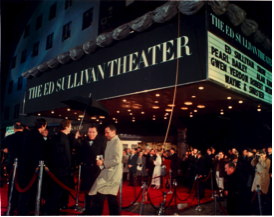
A Timeline of The Ed Sullivan Theater
- 1925-1927 – Arthur Hammerstein builds Hammerstein’s Theater in honor of his father, Oscar Hammerstein I.
- November 30, 1927 – Hammerstein’s Theater opens its doors with a three-hour musical play called The Golden Dawn featuring Archie Leach, who later became known as Cary Grant.
- 1931 – Hammerstein’s Theater is renamed Manhattan Theater.
- 1934 – Manhattan Theater is renamed Billy Rose’s Music Hall and becomes a nightclub.
- 1936 – Billy Rose’s Music Hall is renamed the WPA Theater.
- 1936 – CBS takes over the theater and converts it to a radio theater using various names, including Radio Theater #3 and CBS Radio Playhouse.
- 1950 – With the advent of television, the theater is converted to a television studio named Studio 50.
- 1953 – Studio 50 becomes the home of The Ed Sullivan Show.
- 1960s – Studio 50 also becomes the home of The Merv Griffin Show, To Tell The Truth, What’s My Line and Password.
- 1965 – The studio is converted to a color studio for the beginning of the television season.
- December 10, 1967 – Studio 50 receives its latest name, The Ed Sullivan Theater, to honor its host’s twentieth year. Some people say it was the proudest moment of Ed’s life.
- 1970s – The $10,000 Pyramid and a few other game shows call The Ed Sullivan Theater home.
- 1981 – CBS’s lease expires and the theater is taken over by Reeves Entertainment.
- 1980s – The sitcom Kate and Allie is taped in the theater from 1984 to 1989.
- 1993 – David Letterman leaves NBC to join CBS. CBS buys the theater for $4 million and redesigns the space to hold a 400-seat audience.
- July 15, 2009 – Sir Paul McCartney returns to play on the roof of The Ed Sullivan Theater more than 45 years after The Beatles’ Ed Sullivan Show performance on February 9th, 1964.
- 2015 – David Letterman retires after hosting The Late Show for nearly 22 years. CBS has the theater renovated again during the summer months to prepare it for Stephen Colbert’s tenure as host, which begins that fall.
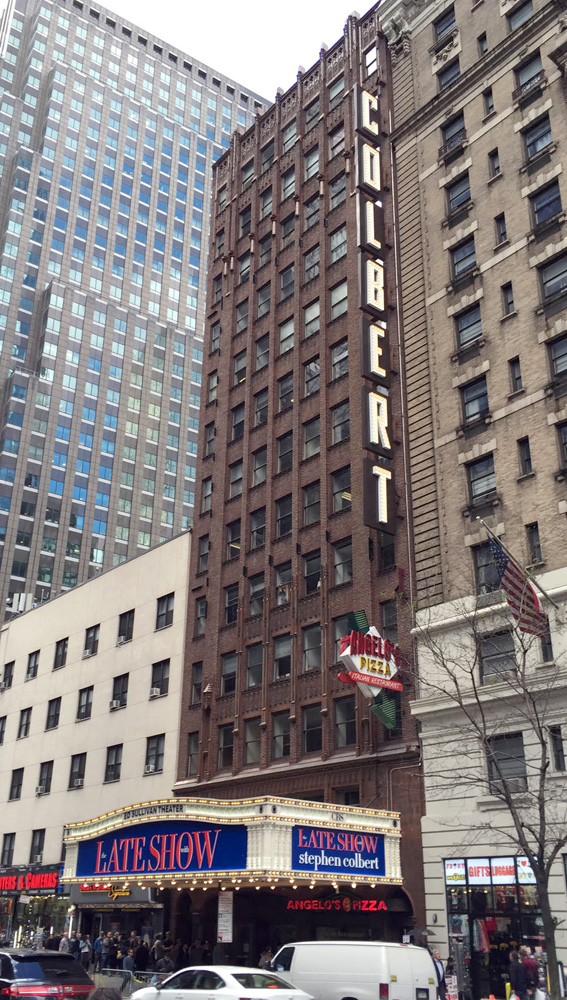
September 2, 1999…A Hard Day At NBC; “Studio 1H” Closes
On September 2, 2016
- TV History
September 2, 1999…A Hard Day At NBC; “Studio 1H” Closes
Inside 30 Rockefeller Plaza, Hurley’s Bar was lovingly called “Studio 1H”. As you can see in the photo below, Hurley’s (which opened in 1892) was just a half a block away from NBC’s studio entrance, making it the nearest watering hole for everyone from stars to stage hands. It became the favorite for radio, television, newspaper and sports celebrities as well as tourists and midtown workers.
Liz Trotta noted “You never knew who would be standing next to your lifting elbow at Hurley’s. Jason Robards, Jonathan Winters, jazz musicians from the local clubs and the ‘Tonight’ show, starlets, football players, the lot.”
Johnny Carson made the Hurley name nationally familiar while he did his show live from Rockefeller Center. It was the bar in all of his Ed McMahon drinking jokes. David Letterman did several on-air visits to the bar.
Hurley’s was known as a place where status was left at the door. Mayor John Lindsay stopped in once, only to be hissed by the patrons. When Henry Kissinger and two bodyguards got noisy, they were ejected by the bartender “for rowdy behavior.”
The bar had been here since 1892 and had always done well, even during prohibition when a florist shop was used to disguise the bar and it’s new back door, but all that history ended September 2, 1999. That night owner Adrien Barbey served the last glass of beer in the bar that had stood at Sixth Avenue and 49th Street for 102 years.
Today, the old Hurely’s location is a bakery (in the aqua circle), and NBC’s 49th Street entrance is a half a block down (in the red circle). The 11 story NBC studio building is just behind Hurley’s. -Bobby Ellerbee


September 2, 1983…The Tom Brokaw Era Begins At NBC
On September 2, 2016
- TV History
September 2, 1983…The Tom Brokaw Era Begins At NBC
In 1983, September 2 was a Friday. That was the day it was announced on the “NBC Nightly News” that beginning Monday, Tom Brokaw would take over as the sole anchor.
On April 5, 1982, Brokaw began co-anchoring NBC Nightly News from New York, with Roger Mudd in Washington. After a year, NBC News president Reuven Frank concluded that the dual-anchor program was not working and selected Brokaw to take over.
Along with Peter Jennings at ABC and Dan Rather at CBS, Brokaw helped usher in the era of the TV news anchor as a lavishly compensated, globe-trotting star in the 1980s. The magnitude of a news event could be measured by whether Brokaw and his counterparts on the other two networks showed up on the scene.
Brokaw’s retirement in December 2004, followed by Rather’s ouster from the CBS Evening News in March 2005, and Jennings’ death in August 2005, brought that era to a close.
In the clip, Tom talks about his early days in Omaha at KMTV and WSB in Atlanta. I remember him from Atlanta, along with fellow reporter Judy Woodruff who was there at the same time. – Bobby Ellerbee
https://www.youtube.com/watch?v=xfR6TXbnNTA
As a new college graduate, journalist Tom Brokaw was newly married to a doctor’s daughter and desperate for a job. Watch as Tom reflects on starting out maki…
Page 16 of 136
« Previous
1
2
3
4
5
6
7
8
9
10
11
12
13
14
15
16
17
18
19
20
21
22
23
24
25
26
27
28
29
30
31
32
33
34
35
36
37
38
39
40
41
42
43
44
45
46
47
48
49
50
51
52
53
54
55
56
57
58
59
60
61
62
63
64
65
66
67
68
69
70
71
72
73
74
75
76
77
78
79
80
81
82
83
84
85
86
87
88
89
90
91
92
93
94
95
96
97
98
99
100
101
102
103
104
105
106
107
108
109
110
111
112
113
114
115
116
117
118
119
120
121
122
123
124
125
126
127
128
129
130
131
132
133
134
135
136
Next »